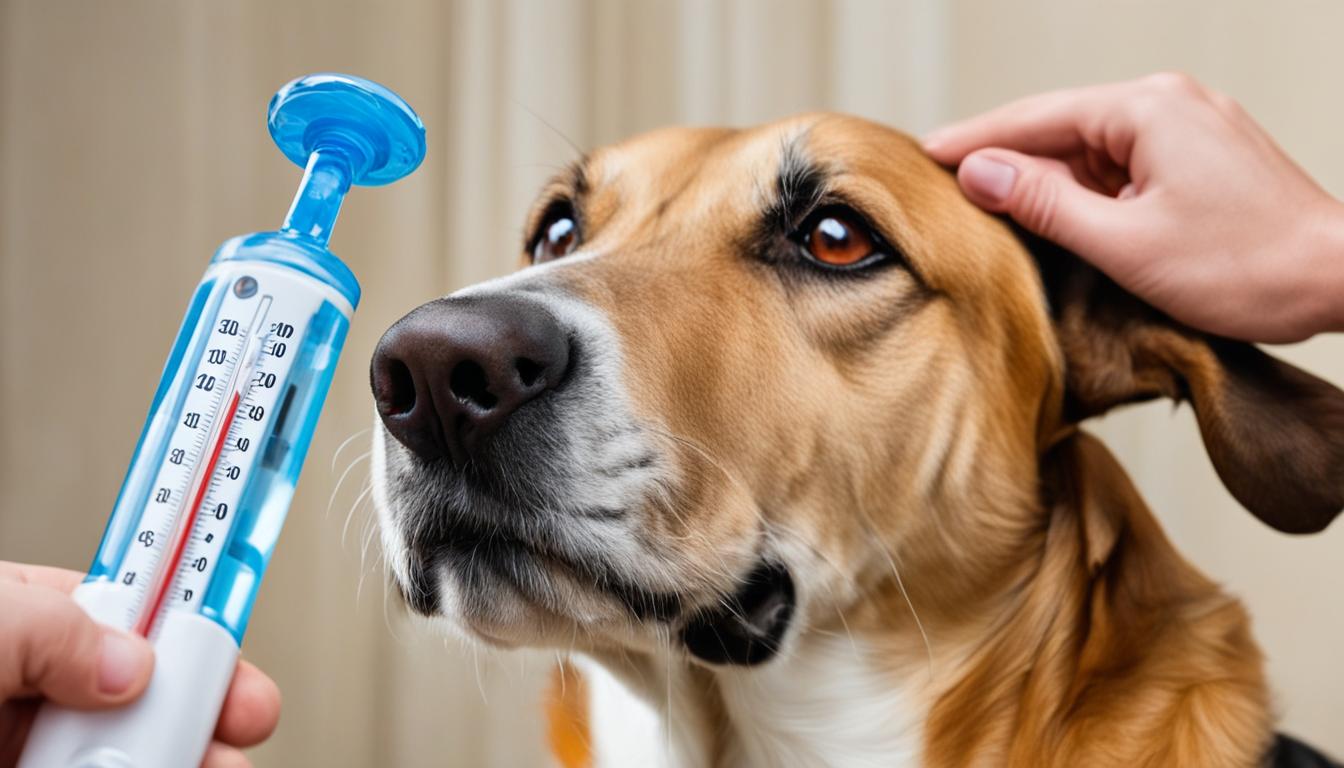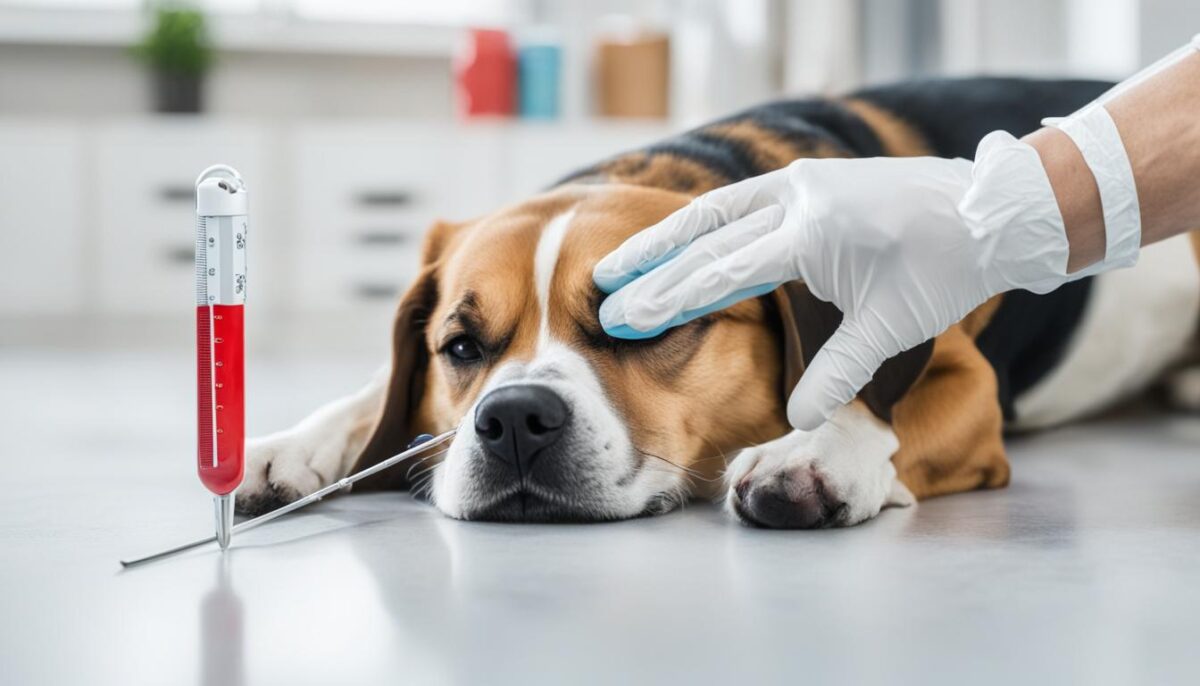Hey there, buddy! If you have a dog, knowing about dog fever symptoms is super important. Dogs can’t tell us when they don’t feel good, right? So, it’s our job to look out for them. Sometimes their nose might be warm, and it could mean a fever. But dogs are a little hotter than us to start with, so it’s not that easy. Let’s learn how to keep an eye on our furry friends’ pet health together!
When you cuddle with your dog, think about how they usually feel. This helps you know when they’re not feeling well. If they’re acting differently, like not wanting to play or eat, they might be under the weather. Keep an eye out for fever in dogs signs, and remember that you’re the best person to catch when something’s not right with your pup!
Key Takeaways
- Get to know how your dog normally feels so you can spot a fever.
- Remember, dogs are warmer than people – that’s normal!
- Warm noses are tricky, they don’t always mean your dog has a fever.
- Seeing if your dog is sleepy or not wanting food can be a fever clue.
- Watching for signs is caring for your pup’s health.
Understanding Your Dog’s Normal Temperature
When it comes to keeping your furry friend healthy, knowing their normal dog temperature is crucial. Dogs have a higher body temperature than we do, so they can feel pretty warm even when they’re just fine. Let’s look at what’s normal for your pet and how to check if they have a fever.
The Range of Normalcy in Canine Body Temperature
Your dog should have a temperature between 99.5 and 102.5°F. This is called the healthy canine temperature range. When you pet them, they might feel toasty, but that could be totally okay for them. Here’s a neat trick: when they are relaxing, touch their paws or ears. They should feel a little bit warm—that’s normal!
Why Dogs Run Hotter Than Humans
Dogs naturally have warmer bodies than us humans. Our normal is usually around 97.6 to 99.6°F, but your dog’s normal can be a bit hotter. It’s just how they’re built! Getting to know what’s normal for your doggo can help tell if something’s up. You might feel their belly or under their collar; if they’re hotter than usual, it’s time to use a pet thermometer.
| Who | Normal Temperature Range |
|---|---|
| Humans | 97.6 – 99.6°F |
| Dogs | 99.5 – 102.5°F |
Now you know that it’s all about knowing what’s typical for your dog. If they’re acting differently and feel warmer than usual, it might be time to check their temperature. That’s the best way to make sure they stay happy and healthy!
How to Tell If a Dog Has a Fever
Is your dog acting unusual? It can be hard to tell when your furry pal isn’t feeling well. If you notice your dog has some of these symptoms of fever in dogs, it might be time to help them out.
- Tiredness: They seem more sleepy than usual.
- Red eyes: Their eyes look redder than normal.
- Warm ears: Their ears feel hotter than they should be.
- Dry nose: Instead of being wet, their nose isn’t as moist.
- Shivering: They shake like they’re cold even when it’s not cold.
- No appetite: They don’t want to eat their favorite treats or food.
- Coughing: If they keep coughing, it’s not a good sign.
- Vomiting: Throwing up is a sure sign something’s wrong.
If your dog is hot and it’s not the weather or because they were running around, they might have a fever. A fever can mean they’re trying to fight off something like a bug or infection. That’s one of the canine fever signs to watch out for.
What if you think your dog has a fever? Here’s what to do if your dog has a fever:
- Keep them cool: Try wetting their paws and giving them water.
- Check their temperature: Use a special thermometer for dogs if you can.
- Visit the vet: They know how to help your dog feel better.
It’s important to learn these signs so you can take care of your buddy when they need you the most. Remember, if you’re worried, go see a vet!
Identifying the Causes of Fever in Dogs
When your dog isn’t feeling well, a fever might be the culprit. A warm forehead or a little shiver might be the first clues. Let’s dive into some reasons your furry friend might have a higher temperature.
Infections and Their Effect on Your Dog
Dog infection symptoms can be tricky to spot. Dogs can get infections from scratches, bites, or even just a bad tooth. These germs make your dog’s body work hard to fight back, which can cause a fever. Keep an eye out for swelling, redness, or pus, which are signs of infection.
The Impact of Environment and Toxins
It’s not just germs that can cause fevers. Sometimes, it’s pet toxicity. Dogs can get sick if they eat things they shouldn’t, like certain plants, human medications, or toxic foods. You might see your dog drooling, having a tummy ache, or acting strange if they eat something bad.
The Response to Vaccinations
Did you know that sometimes dogs get a fever after getting shots? It’s a side effect, but it usually goes away fast. Vaccination side effects may include a tiny fever or just feeling a little bit tired. It’s your pup’s body learning to fight off real germs in the future.
| Possible Fever Cause | Symptoms to Watch For | What to Do |
|---|---|---|
| Infections (Ear, tooth, cuts) | Swelling, pain, redness | See the vet for check-up and treatment |
| Toxins (Bad food, plants) | Drooling, upset stomach, strange behavior | Call the vet, especially if you know what they ate |
| Vaccine Reaction | Tired, a little fever | Give them rest, but call vet if fever lasts more than a day |
Measuring Your Dog’s Temperature Accurately
When your dog is not feeling well, taking their temperature can help you figure out if they have a fever. The right tool for this is a rectal thermometer for dogs or a digital pet thermometer.
To take your dog’s temperature, make sure they are calm. You can pat them to help them feel safe. If you’re using a rectal thermometer, put a little bit of special jelly on the end to make it smooth. Then, carefully put it into your dog’s bottom. You only have to put it in a little bit. If you have a digital thermometer for their ear, you must be gentle too.
- First, find a quiet place where your dog feels comfy.
- Next, if you’re using a rectal thermometer, you might need some help to hold your dog still.
- It’s important to wait until the thermometer beeps. That means it’s done!
- Then, take the thermometer out and look at the number. It tells you if your dog might be sick.
- Last, give your dog a hug or a treat for being good.
Remember, when you take your dog’s temperature, it should be between 99.5 and 102.5 degrees Fahrenheit. If it’s higher, your furry friend might have a fever.
Always be gentle and go slow. This way, you won’t hurt your dog, and you can make sure they’re okay.
Keeping Your Dog Healthy: Fever Care and Advice
When your furry buddy is not feeling well, you might wonder if it’s time to visit the vet. If the temperature check shows your dog is hotter than normal, it’s wise to keep an eye on them. A dog’s fever can mean their body is fighting an illness. Your job is to make sure they get the help they need.
When to Consult Your Vet
If your dog’s temperature goes higher than 103F, or if you feel something is very wrong, it’s time to get help from your vet. Remember, when dogs hit a fever of 106F, it becomes an emergency. The vet knows just what to do, and it’s important to trust their advice for the safety and well-being of your pet.
Home Care Tips for Managing Your Dog’s Fever
To help your dog when they have a fever, try cooling them down with a little water on their paws and ears. This can help lower their fever. Make sure they have water to drink. But remember, never give medicines meant for humans to your dog. When in doubt, it’s always safer to get your dog to the vet for proper canine healthcare. They’ll know just what to do to help your dog feel better.
FAQ
What are common dog fever symptoms to watch for?
Dogs may exhibit signs such as lethargy, red eyes, warm ears, a dry nose, shivering, loss of appetite, coughing, or vomiting when they have a fever.
How can I know what’s a normal dog temperature?
A healthy dog’s body temperature typically ranges between 99.5 and 102.5F, which is above the typical human body temperature range.
Why do dogs have higher body temperatures than humans?
Dogs naturally run hotter than humans due to differences in their physiology, which is why their normal temperature range is higher than ours.
What should I do if I suspect my dog has a fever?
Use a pet thermometer to take their temperature, and consult your vet, especially if the temperature is above 103F or if they exhibit other concerning symptoms.
Can the way my dog’s nose feels indicate a fever?
While a hot and dry nose can sometimes be a sign of fever, it’s not a reliable method to determine a fever as a dog’s nose can vary due to several reasons unrelated to fever.
What causes fever in dogs?
Fevers in dogs can be caused by infections, including bites, cuts, ear or tooth infections, internal issues like urinary infections or diseases affecting organs, exposure to toxins, ingestion of inappropriate foods or human medications, and sometimes as a reaction to vaccinations.
How does the environment affect my dog’s temperature?
Environmental factors like hot weather or excessive exercise can raise your dog’s body temperature, but these are different from a fever, which is a sign of the body fighting an infection or illness.
What is the impact of vaccinations on my dog’s body temperature?
Vaccinations can sometimes cause a mild fever as the dog’s immune system responds to the vaccine, but this should be temporary and subside quickly.
What’s the most accurate way to measure a dog’s temperature?
The most accurate way to measure your dog’s temperature is by using a digital rectal thermometer made for dogs or a digital ear thermometer, following instructions carefully for a correct reading.
When is it necessary to visit the vet for a dog fever?
You should consult your vet if your dog’s temperature exceeds 103F, they exhibit severe symptoms, or if you’re unable to lower their fever using home care methods safely.
Can I use human medicine to treat my dog’s fever?
No, never give your dog medicine meant for humans as it can be very dangerous. Always consult with your vet for safe treatment options.
Are there home care tips to manage my dog’s fever?
Yes, you can help manage mild fever by cooling them down with water on their paws and ears, encouraging them to drink water, and ensuring they rest in a cool, comfortable place. However, for high fevers or if you feel uncertain, a vet visit is crucial.


